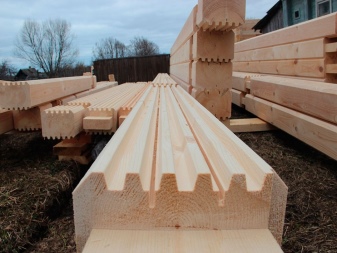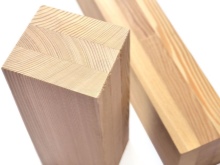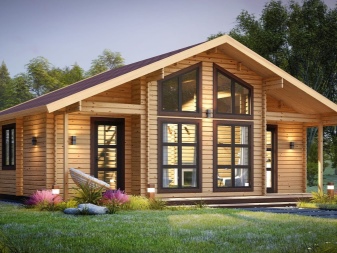Profiled timber dimensions

Any amateur builder should know the dimensions of the profiled beam. The standard dimensions are 150x150x6000 (150x150) and 200x200x6000, 100x150 and 140x140, 100x100 and 90x140. There are other sizes as well, and it is important to choose the right sizes for your particular construction project.
Standard sizes
The wood is distinguished by impressive environmental friendliness and extremely sound quality, its use in the construction industry is quite justified and has a long history. But today it is not necessary to use logs or simple boards - you can use special modern material.


Knowing the dimensions of the profiled timber will allow you to build not only reliable, but also beautiful looking houses and other structures. Moreover, the size directly affects the scope of applicability of certain products.
So, a thickness of 100 mm is typical for a profiled bar:
-
100x150;
-
100x100;
-
100x150x6000;
-
100x100x6000.
These solutions are ideal for light structures such as a summer sauna or veranda. To build a full-fledged residential building, even a one-story lightweight one, will not work out of such material. True, it is quite possible to build a country house designed only for summer conditions from a bar of 150x150. Most often, a pair of spikes and a pair of grooves in the profile are provided. But manufacturers have tweaked the receipt of other options as well.
A thickness of 150 mm is present in a standard profiled bar 150x150x6000 or 150x200; it will be more powerful than the standard 100x150. With dimensions 150x150, there are 7.4 pieces per 1 m3, and with dimensions 150x200 - 5.5 pieces. Usually the use of a comb profile is envisaged. Therefore, the likelihood of freezing houses is sharply reduced. Yes, it is houses - the described material is great for wooden private housing construction.


Option 200x200 (sometimes recorded expanded as 200x200x6000) perfect for the construction of even a large cottage. It is he who is often used by professionals. This solution provides excellent mechanical resistance of the walls to various loads. In some cases, 200x150 products are used. Such a bar is worth more than the two groups described above, but flexible discounts apply when buying in winter.
Many manufacturers offer profiled timber 50x150. Most often it is supplied dry. As for the length, in the overwhelming majority of cases it is 6 m. Therefore, 6x4 timber is the most common category. Materials with other sizes usually have to be ordered separately.


Other dimensions
But it is not always possible to get by with standard sections of dry lumber. Sometimes it is necessary to use products of atypical dimensions. So, the 140x140 models are quite suitable for the arrangement of residential buildings, even with a relatively high load.
The thermal groove will be much more significant than that of 90x140 solutions, and even more so 45x145. And air, as you know, is the best heat insulator found on Earth.
At the same time, the oversized thermal groove also reduces the risk of blowing by the wind; in the southern regions and partly in the middle lane, products with such parameters are quite suitable for permanent year-round buildings.
Profiled timber 190x140 or 190x190 is a much more serious product. It is even suitable for construction in central Russia, in the south of Western Siberia and in other similar places. It is readily used by experienced professionals. However, such material can also be used in the southern regions of the country. There it is prized primarily for its ability to maintain an optimal cool microclimate in summer; and protection from frost is never superfluous.

A 90x140 mm beam is usually used when arranging baths, sheds and wooden garages, and other ancillary structures... In the summer version, it allows you to do without thermal insulation. Experts recommend mounting on wooden pins, which will eliminate distortion and other deformations. Insulation is allowed by attaching siding or cladding with an additional layer of brick. The profiled timber 145x145 has quite decent characteristics - it has an optimal ratio of cost and quality; and for floor decoration, a 45x145 mini-bar is often used.


How to choose a timber for construction?
The specific wood species is critical. Manufacturers mainly try to select softwood. Larch is technically better than spruce or pine. It is slightly more resistant to fire and less cracking when raw. Larch timber will be more thermally inert. However, the cost of such material will be very high.
Linden and oak beams are used less often. The first type is recommended mainly for baths and other "wet" buildings. Oak parts cannot be of significant length or large section. The cost of such products will also not please consumers too much. The choice of square or rectangular sections depends on the specific tasks being solved.



Profiled timber can be dried naturally or in a special chamber. The second option is faster and better, but threatens with cracking of the material. Often attempts are made to prevent this risk by longitudinal filing of the inner planes. But this only reduces the likelihood of the problem, without eliminating it altogether; therefore it is necessary to carefully check the purchased material. Additionally look at:
-
the smoothness of the facial areas;
-
deviations in size;
-
the presence of elements of the "lock";
-
correct packaging (without which it is impossible to ensure acceptable humidity);
-
solid or glued from lamellas execution;
-
profiling option (not all versions make it possible to use insulation);
-
the number of spikes in the profile;
-
the presence or absence of beveled chamfers.
The glued version may be more resistant to deforming effects. Special adhesives suppress the intensity of burning and decay. By default, such products are made in the "German comb" format. The modification known as "warm (double) profiled timber" appeared relatively recently, but has already proved itself. It is firmly established that these structures, only 16 cm thick, can retain heat as effectively as the standard old profile at 37 cm thick.


A single spike bar has a single upwardly directed ridge. This solution prevents the accumulation of water at the connection points and is typical mainly for naturally dried material.
. Such products are often used in the construction of:
-
summer houses;
-
makeshift;
-
change houses;
-
baths;
-
street gazebos.




The double profile type increases mechanical reliability and at the same time reduces heat consumption. The gap separating the spikes allows for thermal insulation. The profile can also have beveled chamfers. This variation of the double profile reduces the likelihood of dampness of the space inside the walls. Importantly, this approach simplifies the caulking work and increases the overall attractiveness of the structures.
Multiple type of profile, also sold under the names "German profile", "comb", implies the use of a large number of grooves. Their height is at least 1 cm. Such a solution guarantees stable fixation of the parts and improves the thermal parameters of the wall. You can even refuse to use additional heaters. But you need to understand that such products tend to gain moisture, especially in wet weather.















The comment was sent successfully.